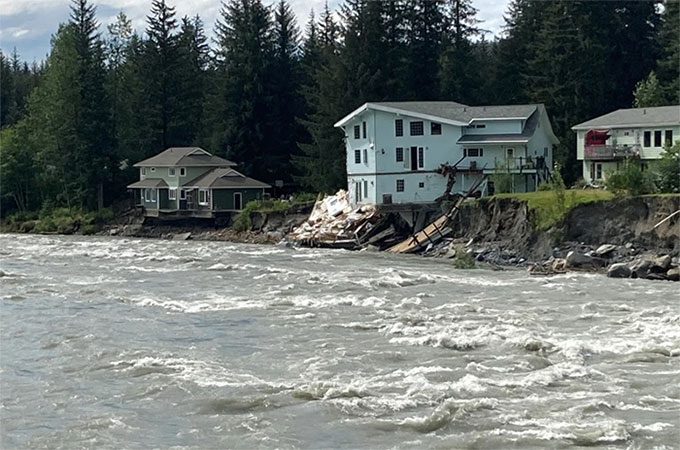A challenge with glacial dam failures is that the severity and timing can vary from year to year.
For over a decade, residents of Alaska’s capital have coexisted with flooding events caused by melting glaciers. However, the flood last weekend astonished scientists due to the rapid and intense rise in river levels, damaging and “swallowing” several homes and forcing some residents to evacuate.

Mendenhall River levels rising along a neighborhood in Juneau, Alaska, on August 6, 2023. (Photo: AP).
The floodwaters are believed to be flowing from a tributary of the Mendenhall Glacier. Eran Hood, a professor of environmental science at the University of Southeast Alaska, stated that glacial dam failures have been occurring in the area since 2011, but the water typically released more slowly, often over several days.
On August 5, the glacial lake levels and flood flows reached record highs in Juneau, home to around 30,000 residents.
According to scientists, climate change is causing glaciers to melt. A study published this year indicates that by the end of the century, glaciers will experience significant melting. Another separate report indicates that glaciers around the Himalayas are melting at an unprecedented rate.
However, scientists say the link between climate change and flooding caused by glacial dam failures, such as those in Juneau, is becoming increasingly complex.
“This phenomenon is climate-driven, but individual flooding events are not directly related to climate, as they are essentially just instances of water overflowing into a basin and then receding at some point during the summer,” Professor Hood pointed out.
Researchers noted that a challenge with glacial dam failures is that the severity and timing can vary year by year.
Celeste Labedz, an environmental seismologist at the University of Calgary, stated that glaciers are very difficult to predict. “As glaciers thin and change, you may see some floods being mitigated, but there will be other floods occurring. Glaciers are a system that can change,” Labedz explained.
In addition to flood risks, reduced ice coverage can diminish water supplies in various regions worldwide and may impact sectors such as agriculture and tourism.
Alaska is a favorite destination for tourists attracted by its rugged landscapes, including mountains and perilous glaciers.
Christian Zimmerman, director of the U.S. Geological Survey in Alaska, stated that glaciers cover approximately 85,000 square kilometers of the state, and the annual ice loss from Alaska’s glaciers would be enough to cover Texas with 10 centimeters of water.
The disappearance of glaciers can also affect ecosystems, including salmon habitats.


















































